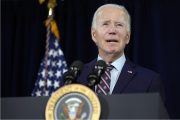
When the book The $3 Trillion War debuted in 2008, it was roundly criticized by such notables as John Lott, Richard Zerbe and Edgar Browning, who held that estimates of the cost of the war in Iraq were overstated. But in a conference call earlier this week, authors Joseph Stiglitz (Nobel Prize winner) and Linda Bilmes (Harvard University professor), said they underestimated those costs by at least one third.
Because the number of veterans needing post-combat medical care is about 30 percent higher than their original estimates, the long-term costs of the wars are likely to exceed $4 trillion. As House Veterans Affairs Chairman Bob Filner (D-CA) exclaimed: “This may be more of a crisis that the Medicare and Social Security problems we have looming. It rivals both in the potential impact. This is another entitlement we’ve committed ourselves to, and it could break the bank.” Admiral Mike Mullen agrees that these costs are “just not sustainable,” with Pentagon health spending tripling in just the past ten years.
When Publishers Weekly reviewed the book in 2008, it said that “Figuring in macro economic costs and interest — the [Iraq] war has been funded with much borrowed money — the cost rises to $4.5 trillion; add Afghanistan, and the bill tops $7 trillion.” And reviewers of the book at Amazon.com noted additional costs, including:
• loss of life and work potential for the private sector
• cost of seriously impaired to society
• mental health costs and consequences
• quality of life impairment
• family costs
• social costs
Other impacts of the wars are higher oil prices, reduction in capital available for investment in the private economy, and increased pressure on the dollar. As one reviewer said, “If you really want to know what the war(s) [will] cost, where each of those costs is hidden and what those costs consist of, then this book is well worth the money.”
Unfortunately, the authors and reviewers have left out the most damaging cost of all: that wars are used to maintain the oppression of the state against the people. This is the conclusion of a controversial study, The Report from Iron Mountain, published in 1967 by Dial Press and then re-published in 1996 by Simon & Schuster. Responses to challenges to the validity of the report authored by a Special Study Group of 15 highly-placed individuals were resolved when one of those involved in the study, Harvard Professor John Kenneth Galbraith, wrote “As I would put my personal repute behind the authenticity of this document, so would I testify to the validity of its conclusions.”
Some of the conclusions of that study include
• war produces waste, which is a way to control surpluses
• war produces jobs and industrial advancement
• >war stimulates the economy
• war “is, and has been, the essential economic stabilizer of modern societies”
• war is “virtually synonymous with nationhood”
• military service has a “patriotic” priority in society
• wars “have provided…[a] state-supported haven…for the ‘unemployable'”
• war can be used as a “…control device over the hostile, nihilistic, and potential unsettling elements of society…”
In a chilling summary of the advantages of war to the state, the report stated:
Government decision-makers tend to choose peace over war whenever a real option exists, because it usually appears to be the “safer” choice. Under most immediate circumstances they are likely to be right. But in terms of long-range social stability, the opposite is true. At our present state of knowledge and reasonable inference, it is the war system that must be identified with stability… [emphasis added]
[War] has insured the subordination of the citizens to the state [emphasis added] by virtue of the residual war powers inherent in the concept of nationhood.
In his expose of the Federal Reserve System, The Creature from Jekyll Island, author G. Edward Griffin studied the Iron Mountain report carefully and concluded that “war has been the only reliable means to achieve that goal [of stability]. It contends that only during times of war or the threat of war are the masses compliant enough to carry the yoke of government without complaint … No amount of sacrifice in the name of victory will be rejected. Resistance is viewed as treason. But, in times of peace, people become resentful of high taxes, shortages, and bureaucratic intervention. No government has long survived without enemies and armed conflict. War, therefore, has been an indispensable condition for “stabilizing society.”
That is the true cost of wars.

